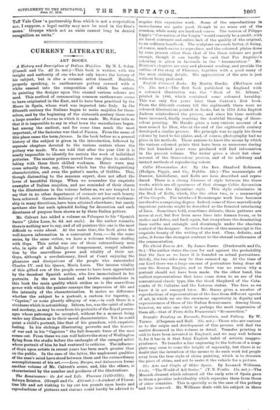CURRENT LITE RAT U R,E.
ART BOOKS.
A History and Description of Italian Majolica. By M. L. Solon. (Cassell and Co. £2 2s. net.)—This book is written with the insight and authority of one who not only knows the history of his subject, but is also a ceramic artist himself. Majolica, properly speaking, is earthenware pottery covered with a white enamel into the composition of which fire enters. In painting the designs upon this enamel various colours are used. This method of ornamenting common earthenware seems to have originated in the East, and to have been practised by the Moors in Spain, whose work was imported into Italy. In the fifteenth century the Italians began to make majolica for them- selves, and by the beginning of the sixteenth century there were a large number of towns in which it was made. Mr. Solon tells us that it is impossible to say in what town the manufacture began, but among the earliest, and for some time much the most important, of the factories was that of Faenza. From the name of this place came the term faience. In the book before us a general history of the subject is given in the introduction, followed by separate chapters devoted to the various centres where the pottery was made. We are told that after the year 1500 it is nearly impossible to identify for certain the work of individual potteries. The master potters moved from one place to another, taking with them their skilled workmen. Hence ware may come actually from, say, Urbino which has the distinguishing characteristics, and even the potter's marks, of Gubbio. This, though distracting to the museum expert, does not affect the lover of beautiful things. When we remember the exquisite examples of Italian majolica, and are reminded of their charm by the illustrations in the volume before us, we are tempted to say that in no other department of ceramic art has such beauty been achieved. Greater delicacy of finish, more perfect workman- ship in many directions, have been attained elsewhere; but surely nowhere else has such splendid feeling for decoration and such directness of purpose been shown as by these Italian potters.
Mr. Calvert has added a volume on Velasguez to his "Spanish Series" (John Lane, 3s. 6d. net each). As the author remarks, there is nothing new to say, and of all painters this one is the most difficult to write about. At the same time, the book gives the well-known information in a convenient form.—In the same series, by the same writer, we have a welcome volume dealing with Goya. This artist was one of those extraordinary men who, in spite of all failings of temperament, compel admira- tion by the marvellous power and vitality of their art. Goya, although a revolutionary, lived at Court enjoying the pleasures and dissipations of the people who surrounded Charles IV. and his Queen, Maria Luisa. The intense vitality of this gifted son of the people seems to have been appreciated by the decadent Spanish nobles, who live immortalised in his portraits. In the six hundred and twelve reproductions in this book the main quality which strikes us is the marvellous power with which the painter conveys the impression of life and the intensity of the characterisation. It makes no difference whether the subject be a portrait. a cartoon for tapestry, a "Caprice," or some ghastly allegory of war,—in each there is a vividness which is astonishing. Inborn, too, was the spirit of satire and mockery, as may be seen from his portraits of the Royal person- ages whose patronage he accepted, without for a moment being under any illusion as to their moral characteristics. Yet he could paint a child's portrait, like that of his grandson, with exquisite feeling. In his etchings illustrating proverbs and the horrors of war and in his "Caprices" the full demonic force of the man comes out. From these we can well believe the story of Wellington flying from the studio before the onslaught of the enraged artist whose portrait of him he had ventured to criticise. The influence of Goya upon artists in recent years has been much greater than on the public. In the case of the latter, the unpleasant qualities Of the man's mind have stood between them and the extraordinary accomplishment of his art.—Leon, Burgos, and Salamanca forms another volume of Mr. Calvert's series, and, like the others, is characterised by the number and goodness of the illustrations.






















































 Previous page
Previous page